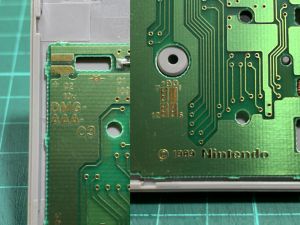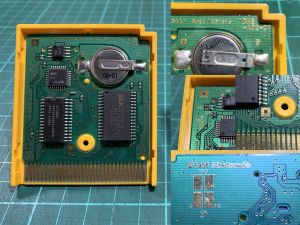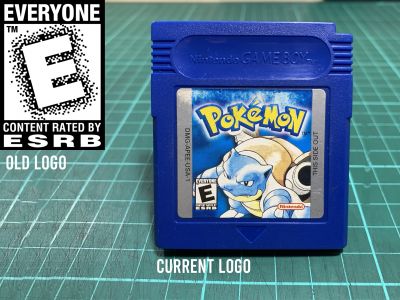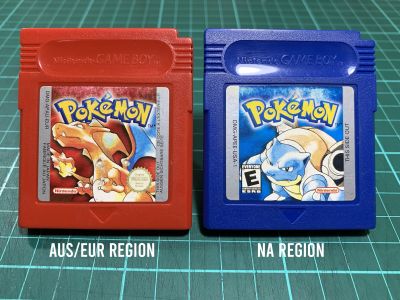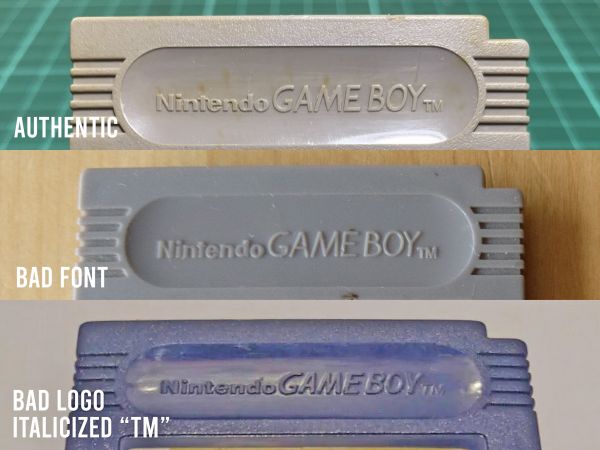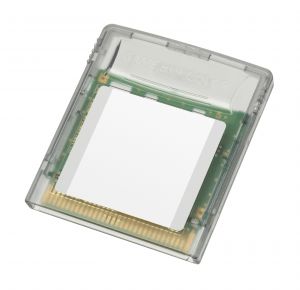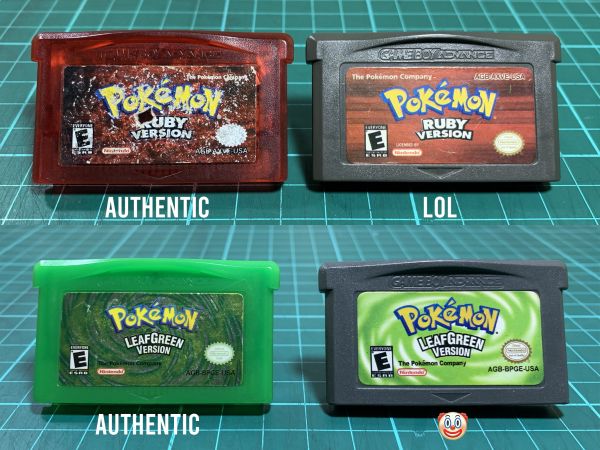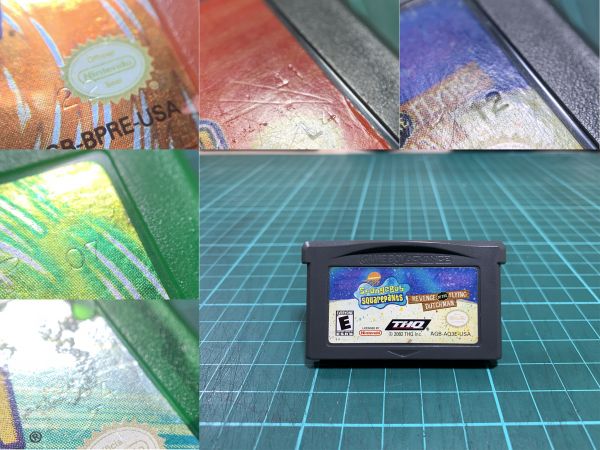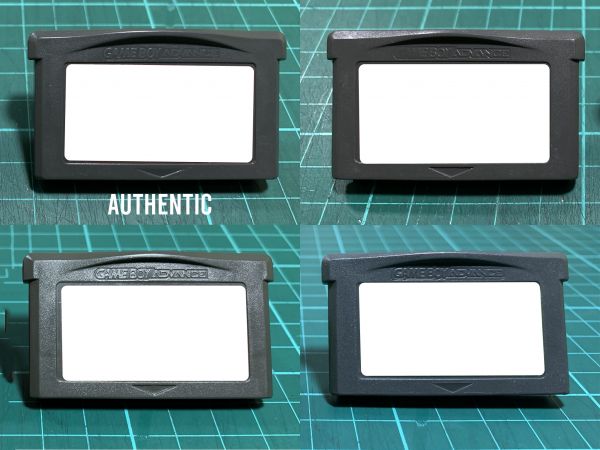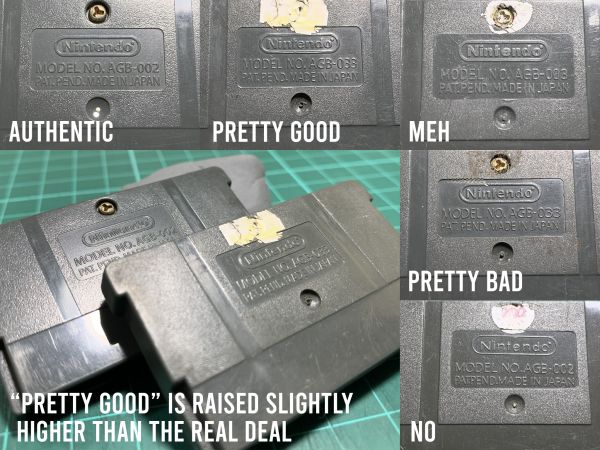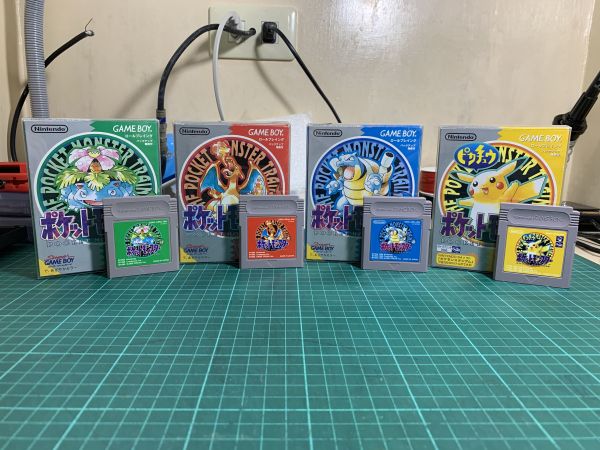Game Boy:Identifying Fake Carts
This guide has been adapted from a post originally made by /u/SeanOrtiz on the r/Gameboy Subreddit. All credit for the text and photos belong to them.
Identifying Cartridges Internally
Step-by-Step
- Open your desired cart.
- Follow one of the following ways to identify an authentic cart:
- The first way is to just search for "[name of game] authentic cart" and compare images. Many popular games are well documented.
- The second way to find gold squares, trims, patterns, Nintendo logos, etc. on the board. Bootleggers never exert the money or effort into copying these patterns.
Important Notes
- While it's often an indicator of a fake cart, some early DMG games have black blobs over their chips. Tetris is one such example.
- Just because yours "looks a little bit different" doesn’t immediately mean it’s fake. Cart revisions in the middle of production are more common than people think.
- Some GBA games have batteries and some don't, but ALL GBA games have a rectangular slot molded into the front half for battery terminals. If it's missing, it is fake.
Identifying Cartridges Externally
Intro
The rest of the post if for identifying games without opening the cart. It will be divided into four sections:
- DMG games
- GBC games
- GBA games
- Pokemon games
The sections will have their own subsections pertaining to the carts' labels, the carts themselves, and other factors miscellaneous to consider. There's going to be a section dedicated to the visible portions of the board for GBA games and translucent carts such as Pokemon Crystal and gen 3 Pokemon games. Many of the content will also be copy/pasted as a lot of them are essentially the same. There is also a section called "How good can bootlegs get?" which talks about bootlegs and how good they can get.
Essentially, when Nintendo was making these carts, they anticipated that people were going bootleg their games. They've been leaving breadcrumbs of authenticity from the very start and all we're doing is spotting them.
Rule of Thumb
The general rule of thumb for most of these basically comes down to 2 things:
- Familiarizing yourself with those said breadcrumbs diplayed by authentic carts.
- Evaluating how accurate those details are displayed on the cart you're identifying, if they're even present at all.
You should keep these 2 principles at the back of your head when trying to identify fakes.
Do note: a lot of characteristics for identifying authentic carts carry over so a lot of what follows are copy/pasted. If you're looking for a specific section, just CTRL+F to find what you're looking for.
How to identify authentic DMG GAMES
Label
- Label art is mostly not the same as the box art. The best way to find your game's proper label art is to put on your big boy/girl pants and learn how to Google search.
- The label should have a factory imprint on it like two numbers or a number and a letter. These thing fade over time though and labels can easily be replaced.
- Some DMG games will also have grey borders on the left and right sides with the game's serial code and region writen on them.
- Don't be afraid if yours doesn't have them, some games just don't have grey borders.
- The ESRB Rating of "E for everyone" logo varies. ESRB revised logos within this generation of games so earlier games should have the old logo and later games should have the current logo. A popular example of games that changed ESRB logos in between prints is Pokemon Red, Blue, and Yellow.
- Be aware of regional variants of label arts. ESRB has no judistriction outside of the US and PEGI wasn't a thing at the time.
- If the label looks like it was printed from a home printer, what do you think?
- Don't forget to check the code printed on the label to see if it matches the game. From my experience though, other factors should already be so obvious at this point that this step is almost never necessary.
Cart
- If it doesn't say "NintendoGAMEBOY™" on top, it's a guaranteed bootleg.
- Check the "NintendoGAMEBOY™" on the top/grip part.
- The Nintendo logo has never changed fonts since the 70's. Nintendo's logo is supposed to be thick vertically while thin horizontally.
- If the font looks like it's consistent in its thickness, if the "t" looks like it has a tail like a "j", if anything looks off even with just a single letter, that's a red flag.
- Do note that the "e" is kinda weird. I've seen a few pics and vids of carts that have a different looking "e" but are verified authentic.
- I've also seen pics and videos of carts with less obvious variations in thicknesses in the Nintendo logo's font.
- If artwork looks unprofessional, it is likely a fake.
- The "GAME BOY" part should be thinner than the Nintendo logo. It should also be somewhat italicized. It should be more of a "GAME BOY" as opposed to just "GAME BOY".
- The "™" should be the smallest and the thinnest.
- All of these should be all aligned at the bottom. If one is raised higher than than the others, that's a red flag.
- The Nintendo logo has never changed fonts since the 70's. Nintendo's logo is supposed to be thick vertically while thin horizontally.
- Other moldings include the down arrow which is often too deep on most bootlegs.
Items of Note
- This was an era when Nintendo used to off-load some manufacturing to others.
- I've seen some pics and videos of verified authentic carts with the Nintendo logo on the grip isn't necessarily 1:1 with Nintendo's actual logo.
- Just looking up different variations of the game Alleyway shows as much.
- It should be pretty obvious but I'll say it anyway. No one singular characteristic qualifies your cart as authentic, nor does one single element disqualify it.
How to identify authentic GBC games
Label
- Label art is mostly not the same as the box art. The best way to find your game's proper label art is to learn how to Google search.
- The label should have a factory imprint on it like two numbers or a number and a letter. These thing fade over time though and labels can easily be replaced.
Cart
- GBC games are sort of an odd ball. There are essentially two types:
- GBC with black (or yellow) DMG cases to show that they are backwards compatible with the DMG; and
- GBC games with translucent grey cart cases.
- GBC games with black DMG cases (or special colors like the Western Pokémon releases) follow the same rules as the DMG games stated above.
- GBC games with translucent cases are guaranteed to be the real deal. No bootlegs have ever replicated these at all.
- The closest we've come to a proper bootleg translucent case is Krikzz's Everdrive.
- Even with Krikzz's Everdrives, it only says "GAME" on the top of the cart. Most likely intentional to differentiate from the real deal.
- Authentic translucent grey carts should say "GAME BOY COLOR".
- Some bootlegs of the games with translucent carts either use black carts or custom colored carts. The only way to tell if a specific game is supposed to be in a black cart or a translucent cart is to Google it.
Board
- When it comes to grey translucent GBC, identifying whether the board is authentic or not should be very easy even without opening the cart. Is there a battery visible at the upper right? Yes? Congrats, it's legit.
- Some carts have the batteries oriented diagonally and others have them oriented horitontally. No biggie; all the same.
How to identify authentic GBA games
Label
- Label art should not be the same as the box art. The best way to find your game's proper label art is to learn how to Google it.
- The label should have a factory imprint on it like two numbers or a number and a letter. These thing fade over time though and labels can easily be replaced.
- ESRB's logos are NOT a good way to identify bootlegs. If you search for images of different carts, you'll see that the only thing consistent about them is their inconsistency.
- Unless they're unusually thin, like, not even in bold style font. Thin "E"s are usually a dead givaway for bootlegs.
- You'll catch these hands if you show me another label that looks like it was printed from a 90's VHS player 😤😤😤.
- Don't forget to check the code printed on the label to see if it matches the game. From my experience though, other factors should already be obvious at this point so this step isn't necessary.
Cart
- "GAME BOY ADVANCE" should be shallowly etched under the grip/lip.
- Bootlegs have a tendency to mold everything too deep. Everything from the "GAME BOY ADVANCE" down to the arrow at the bottom.
- The back of the cart should also have stuff etched onto it. Most bootlegs won't get Nintendo's logos right. Nintendo's logo is thick vertically and thin horizontally. If the font is consistent in its thickness, it's bootleg.
Board
- Without opening the cart, a portion of the board should still be visible.
- Above the gold terminals, the Nintendo logo should be visible followed by a serial code.
- Some Nintendo logos are enclosed in circles while others aren't. No biggie, we don't discriminate.
- If the font of the Nintendo logo doesn't look right or if the quality of the print looks shoddy, it's probably a bootleg.
- The majority of the motherboard shouldn't be visible from the bottom either. Some bootlegs have their entire boards exposed from the bottom.
How to identify authentic Pokémon games
Gen 1 (Red, Green, Blue, and Yellow)
Label
- Bootleg gen 1 Pokémon games tend to be really bad.
- The label art should never be just the box art. If yours has "GAME BOY" writen vertically next to Blastoise, it's bootleg.
- As mentioned earlier, the ESRB Rating of "E for everyone" logo varies. ESRB revised logos in between prints so some carts have the old logo and some with the current logo.
- The old logo looks like a mist of dots in the outline of an "E" so don't be concerned if this is what you have. It's most likely just an earlier print.
Cart Colors
- The only thing special about these carts is that they're the only colored ones in a see of grey and black DMG carts.
- If your Pokémon cart is grey or black, it's a guaranteed bootleg.
- Unless it's Japanese. Japanese versions of Green, Red, Blue, and Yellow should all be in grey carts.
Other factors
- Pokemon Green was NEVER released outside of Japan. If your green isn't Japanese, it's 100% guranteed bootleg.
- Identification of DMG carts stated earlier still apply.
- Be suspicious of seller listings for full sets or cheap items. Bootlegs are rampant for Pokemon games.
Gen 2 (Gold, Silver, and Crystal)
Label
- The labels for Gen 2 games should have a metallic effect, not glossy. Think hollow/foil trading cards.
- A serial code should be imprinted onto the label. These might fade or be less obvious on less cared for carts.
Cart Colors and Translucency
- Gold and Silver should be Gold and Silver respectively with glitters on them.
- Crystal should be translucent blue and glittery as well.
- Fun fact: for the Japanese versions, the front half of Gold should be dark blue and the back half should be a dark grey. The Japanese Silver is the exact opposite. Crystal should be similar to the western versions but it should have a crystal printed on the back of the board visible from the outside.
Board (for Crystal only)
- Given the translucency of Crystal's cart, identifying whether the board is authentic or not should be very easy even without opening the cart (not that you even need to).
Other factors
- Identification of DMG carts stated earlier still apply to Gold and Silver while identification of GBC carts apply to Crystal.
- Be suspicious of seller listings for full sets or cheap items. Bootlegs are rampant for Pokémon games.
Gen 3 (GBA Games)
- The absolute 'fastest way to verify a gen 3 Pokémon game is look the battery terminals in the front. The carts are translucent and you should be able to see them easily. If there's only a battery but no molding on the space on the cart for the terminals, it's bootleg.
Labels have been too unreliable in too many occasions. Labels' metallic gloss and factory imprints can easily be nulled by a bad photo. Not everybody's rich enough to have a DSLR camera or an iPhone/Pixel.
If you can't find it, look at the back and find the 4 gold rectangles on the back of the board. If they're there, it's authentic. If they're not, then there is no and's, if's, or but's about it. It's bootleg.

Label
- The labels should have either gem-like or metallic effects, not glossy. Think hollow/foil trading cards.
- A serial code should be imprinted onto the label. These might fade or be less obvious on less cared for carts.
Cart Colors and Translucency
- Translucent colored carts. The carts should be the right colors and amount of translucency.
- Fire Red and Leaf Green shouldn't be as translucent as Ruby, Sapphire, and Emerald. It should barely show in a lot of photos.
Board
- Given the translucency of these carts, identifying whether the board is authentic or not should be very easy even without opening the cart.
- The Nintendo logo and the serial code in the proper font above the gold terminals. Some carts will have the Nintendo logo with just "Nintendo" writen and some will have the enclosed logo.
- For Ruby, Sapphire, and Emerald, the batteries should not only be visible but should be oriented properly with one terminal pointed towards the lower left and the other pointed towards the upper right.
- There should also be space molded into the cart's front half in the same orientation as the battery's terminals. The two corners of this rectangular molding should easily be visible around the upper right corner of the label.
- Fire Red and Leaf Green should have no batteries at all but the rectangular molding for the battery terminals should still be visible on the carts.
- As stated earlier, the 4 gold rectangles on the back of the board which should be visible even with Fire Red and Leaf Green's less translucent carts, those alone guarantee the carts authentic.
Other factors
- Identification of GBA carts stated earlier still apply.
- Be suspicious of seller listings for full sets or cheap items. Bootlegs are rampant for Pokémon games.
Misc. Tips
Here are some more tips based on the posts I've observed:
Screws
- I've seen a few people mention screws as being a factor to consider. A total non-issue, IMO. If you see a game with a Philips head or whatever, it's obviously bootleg. Most bootlegs are gonna have the right screws though.
- Personally, I've never even seen or heard of a bootleg with the wrong screw.
Labels
- A lot of bootlegs don't even try.
- To my knowledge, serial code imprints have never been replicated.
- To my knowledge, Pokémon gens 2 and 3 metallic labels have never been properly replicated.
- Some have tried. Some can even get pretty close.
- If it looks unprofessional, it likely is a fake.
Carts
- When it comes to a DMG's "Nintendo GAME BOY™", there are quite a few bootlegs that look like they're pretty close at first glance.
- In these situations, something they have in common is improper fonts and thicknesses.
- Examples I've seen came close but showed to be bootleg through improper fonts and styles.
- If it's really that convincing, a combination of other factors should be taken into account.
Regional variants
- Generally, assume that most non-US games aren't bootleg.
- Most bootlegs I've seen online and encountered IRL have been ripped from the US carts.
- Regional bootlegs do exist, though. Some are even really convincing at first glance.
- As usual, while some are good, the rest are garbage. A lot of these are pretty blatantly bootleg once you've gone through the guide I've writen 😁
- Again, the most obvious is Pokémon Green. It NEVER came out in regions outside of Japan. If it's not Japanese with a grey cart, it's 100% bootleg.
- Some people buy them anyway though. Especially the English translated ROM hacks with the green carts to match the gen 1 carts.
- Those people know they're bootleg. Don't fucking bust their balls about it, dawg. Just let them have their fun.
